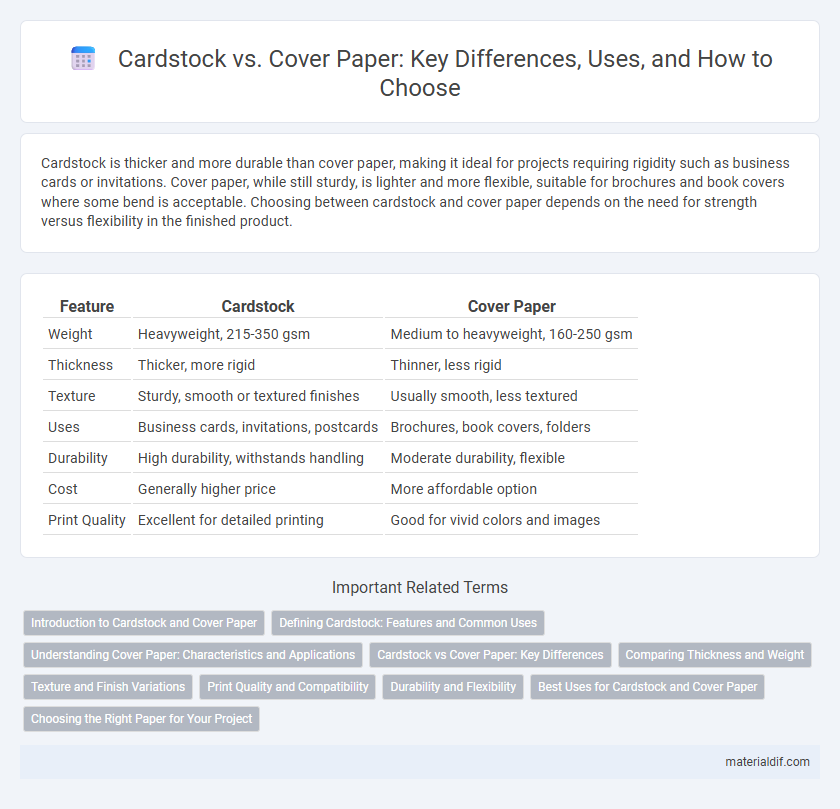Cardstock is thicker and more durable than cover paper, making it ideal for projects requiring rigidity such as business cards or invitations. Cover paper, while still sturdy, is lighter and more flexible, suitable for brochures and book covers where some bend is acceptable. Choosing between cardstock and cover paper depends on the need for strength versus flexibility in the finished product.
Table of Comparison
| Feature | Cardstock | Cover Paper |
|---|---|---|
| Weight | Heavyweight, 215-350 gsm | Medium to heavyweight, 160-250 gsm |
| Thickness | Thicker, more rigid | Thinner, less rigid |
| Texture | Sturdy, smooth or textured finishes | Usually smooth, less textured |
| Uses | Business cards, invitations, postcards | Brochures, book covers, folders |
| Durability | High durability, withstands handling | Moderate durability, flexible |
| Cost | Generally higher price | More affordable option |
| Print Quality | Excellent for detailed printing | Good for vivid colors and images |
Introduction to Cardstock and Cover Paper
Cardstock is a thick, sturdy paper known for its durability and rigidity, commonly used in crafting, invitations, and business cards. Cover paper, while also heavier than regular paper, is slightly lighter and more flexible, ideal for book covers and brochures. Both types offer distinct textures and weights that influence their suitability for specific printing and design projects.
Defining Cardstock: Features and Common Uses
Cardstock is a heavy, thick paper known for its durability and rigidity, typically ranging from 50 to 110 lb in weight, making it sturdier than standard paper but lighter than cardboard. Its smooth finish and ability to hold ink well make it ideal for business cards, invitations, postcards, and scrapbooking. Commonly available in various colors and textures, cardstock is favored for projects requiring a professional, polished appearance combined with structural integrity.
Understanding Cover Paper: Characteristics and Applications
Cover paper is a heavyweight paper typically ranging from 60 to 110 lbs, known for its stiffness and durability, making it ideal for covers, business cards, and postcards. Its smooth or textured finish enhances print quality and provides an attractive surface for various printing techniques including digital, offset, and letterpress. Commonly featuring higher opacity and thickness than standard text paper, cover paper resists bending and tearing, ensuring professional and long-lasting applications.
Cardstock vs Cover Paper: Key Differences
Cardstock is thicker and more durable than cover paper, typically measuring between 50 lb to 110 lb in weight, making it ideal for business cards, postcards, and invitations. Cover paper is lighter, usually ranging from 60 lb to 100 lb, and is commonly used for magazine covers, brochures, and book jackets due to its smooth finish and flexibility. The primary difference lies in thickness and stiffness, with cardstock offering superior rigidity and cover paper providing a balance between sturdiness and pliability.
Comparing Thickness and Weight
Cardstock typically ranges from 50 lb to 110 lb in weight and measures between 0.005 to 0.012 inches in thickness, making it sturdier and more rigid than cover paper. Cover paper usually weighs around 65 lb to 100 lb with a thickness of approximately 0.003 to 0.008 inches, offering flexibility ideal for covers and brochures. Comparing thickness and weight, cardstock provides increased durability and support, whereas cover paper balances strength with pliability for decorative and protective purposes.
Texture and Finish Variations
Cardstock typically features a thicker, more rigid texture than cover paper, making it ideal for durable projects such as business cards and invitations. Cover paper offers a smoother finish with greater flexibility, often used for brochures and flyers where a polished appearance is essential. Both materials provide varied finish options, including matte, glossy, and satin, allowing customization to match specific aesthetic and tactile preferences.
Print Quality and Compatibility
Cardstock offers superior print quality due to its thicker, more rigid structure, making colors appear more vibrant and text sharper, ideal for high-end invitations and business cards. Cover paper, while lighter and more flexible, provides adequate print quality suitable for brochures and flyers, and is generally more compatible with a wider range of printers. Compatibility-wise, cardstock often requires specialized printers or settings to avoid jamming, whereas cover paper works efficiently with most standard inkjet and laser printers.
Durability and Flexibility
Cardstock offers superior durability with a thicker, stiffer composition ideal for projects requiring rigidity, while cover paper provides greater flexibility due to its thinner, more pliable structure. The higher gsm (grams per square meter) of cardstock enhances its resistance to bending and tearing, making it suitable for durable print materials like business cards and invitations. Conversely, cover paper's lightweight nature allows for easier folding and manipulation, preferable for brochures and lightweight book covers.
Best Uses for Cardstock and Cover Paper
Cardstock is best used for durable projects such as business cards, invitations, and scrapbooking due to its thick and sturdy texture, typically ranging from 50 lb to 110 lb weight. Cover paper, lighter and smoother with weights between 60 lb and 100 lb, excels in applications like brochures, flyers, and covers for booklets where flexibility and professional finish are essential. Choosing cardstock ensures rigidity and long-lasting quality, while cover paper provides versatility for vibrant printing and easy folding.
Choosing the Right Paper for Your Project
Cardstock offers a thicker, more durable option ideal for projects requiring rigidity, such as invitations or business cards, while cover paper is lighter and more flexible, suited for brochures and flyers. Selecting the right paper depends on the project's purpose, required durability, and print quality, with cardstock providing superior stability and cover paper allowing for easier folding and handling. Assessing weight, finish, and texture ensures the chosen paper aligns with both the aesthetic and functional needs of your print project.
Cardstock vs Cover Paper Infographic

 materialdif.com
materialdif.com